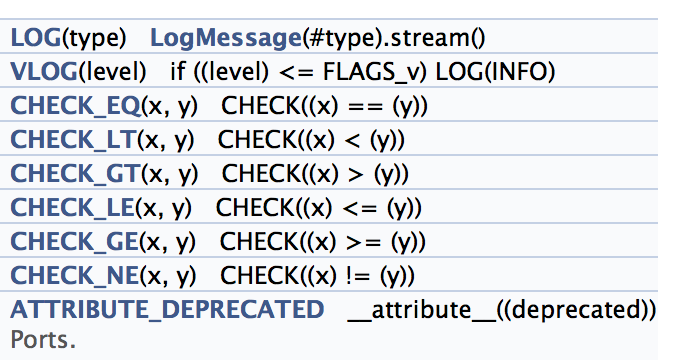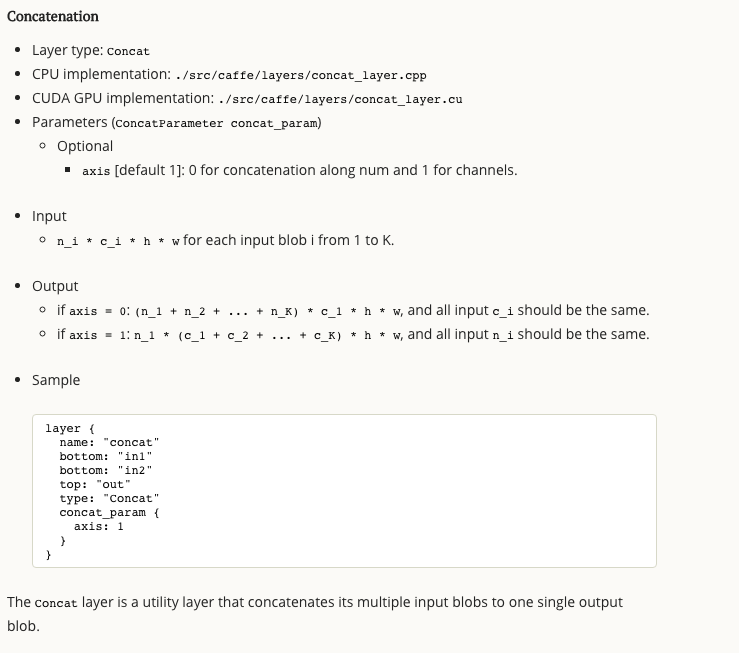Caffe 程式碼解讀之全連線層concat layer
阿新 • • 發佈:2019-02-08
今天,我們看一下caffe的拼接層,即將兩個或多個layer進行拼接。
首先,看一下caffe官方文件。
同其他layer一樣,分為setup、reshape、Forward_cpu、Backward_cpu。
//concat_layer 用來實現兩個或者多個blob的連結,即多輸入一輸出
//支援在num 維度上的連結(concat_dim = 0 : (n1+n2+...+nk)∗c∗h∗w )
//和channel維度上的連結(concat_dim = 1 : n∗(c1+c2+...+ck)∗h∗w)。
//axis ,dim :0 為 num 維度連結,1 為 channel 維度連結 1、這裡有一點需要解釋,可以看到,bottom型別為 vector blob,這裡只需要使用bottom[0]給shape賦值就好,其實bottom本身就是一個Blob的vector。
2、CHECK_**,這裡給小白們解釋一下,就是判斷是否相等、小於、大於

3、 count,這看到有好多的count函式,這些函式在blob層實現,解釋如下:
inline int count() const { return count_; }
/**
* @brief Compute the volume of a slice; i.e., the product of dimensions
* among a range of axes.
*
* @param start_axis The first axis to include in the slice.
*
* @param end_axis The first axis to exclude from the slice.
*/
inline int count(int start_axis, int end_axis) const {
CHECK_LE(start_axis, end_axis);
CHECK_GE(start_axis, 0);
CHECK_GE(end_axis, 0);
CHECK_LE(start_axis, num_axes());
CHECK_LE(end_axis, num_axes());
int count = 1;
for (int i = start_axis; i < end_axis; ++i) {
count *= shape(i);
}
return count;
}
/**
* @brief Compute the volume of a slice spanning from a particular first
* axis to the final axis.
*
* @param start_axis The first axis to include in the slice.
*/
inline int count(int start_axis) const {
return count(start_axis, num_axes());
}
前向傳播就是layer的拼接
template <typename Dtype>
void ConcatLayer<Dtype>::Forward_cpu(const vector<Blob<Dtype>*>& bottom,
const vector<Blob<Dtype>*>& top) {
Dtype* top_data = top[0]->mutable_cpu_data();
int offset_concat_axis = 0;
const int top_concat_axis = top[0]->shape(concat_axis_);
//遍歷所有輸入bottom
for (int i = 0; i < bottom.size(); ++i) {
const Dtype* bottom_data = bottom[i]->cpu_data();
const int bottom_concat_axis = bottom[i]->shape(concat_axis_);
//把 各個bottom data 拷貝到輸出 top data 的對應位置
for (int n = 0; n < num_concats_; ++n) {
//case 0:num x channel x h x w;case 1: channel x h x w
//case 0:bottom_data + n x num x channel x h x w ;
//case 1:bottom_data + n x channel x h x w ;
caffe_copy(bottom_concat_axis * concat_input_size_,
bottom_data + n * bottom_concat_axis * concat_input_size_,
top_data + (n * top_concat_axis + offset_concat_axis)
* concat_input_size_);
}
offset_concat_axis += bottom_concat_axis;
}
}反向傳播,就是layer層之間diff和data的傳播
//反向傳播就是對每一個bottom的 diff 做和 data 相同的連結
template <typename Dtype>
void ConcatLayer<Dtype>::Backward_cpu(const vector<Blob<Dtype>*>& top,
const vector<bool>& propagate_down, const vector<Blob<Dtype>*>& bottom) {
const Dtype* top_diff = top[0]->cpu_diff();
int offset_concat_axis = 0;
const int top_concat_axis = top[0]->shape(concat_axis_);
for (int i = 0; i < bottom.size(); ++i) {
if (!propagate_down[i]) { continue; }
Dtype* bottom_diff = bottom[i]->mutable_cpu_diff();
const int bottom_concat_axis = bottom[i]->shape(concat_axis_);
for (int n = 0; n < num_concats_; ++n) {
caffe_copy(bottom_concat_axis * concat_input_size_, top_diff +
(n * top_concat_axis + offset_concat_axis) * concat_input_size_,
bottom_diff + n * bottom_concat_axis * concat_input_size_);
}
offset_concat_axis += bottom_concat_axis;
}
}
